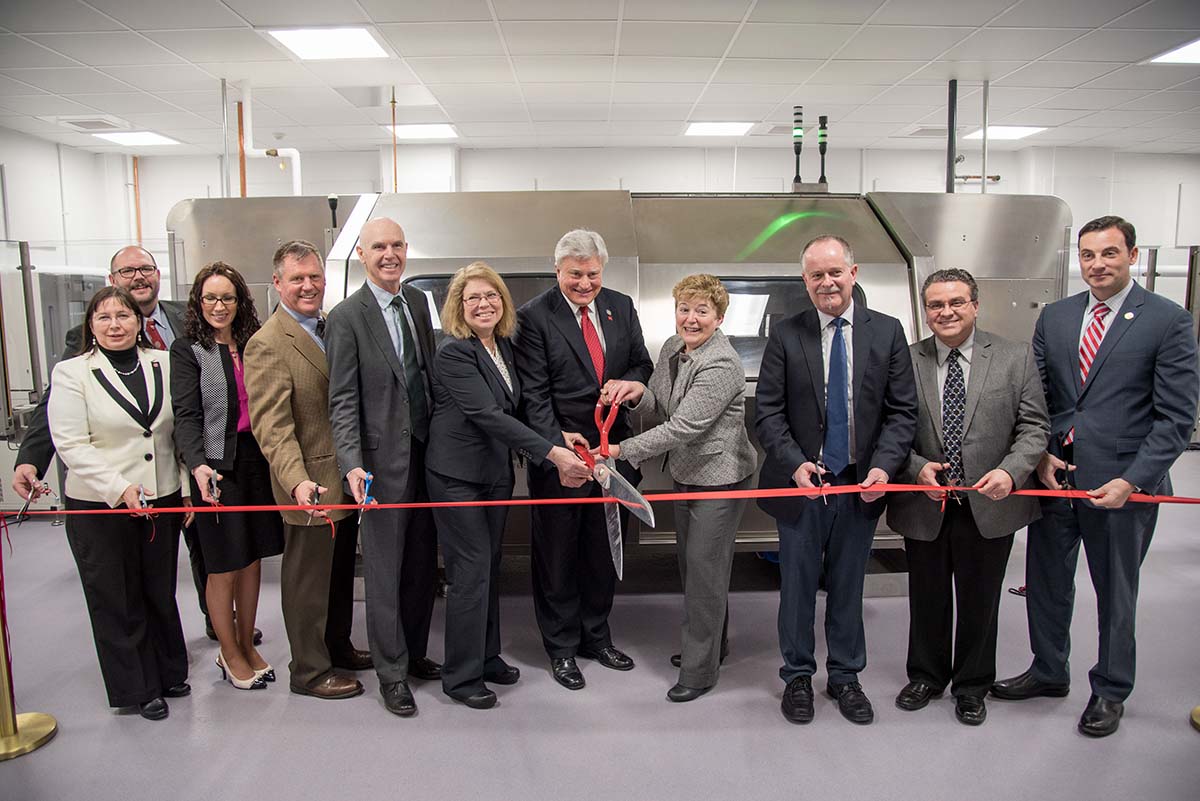New high-pressure processor destroys foodborne pathogens
By Krisy Gashler
Cornell food scientists are putting the squeeze on the microorganisms that spoil food and make people sick.
With the installation of a new high-pressure food processor, the College of Agriculture and Life Sciences has become the nation’s first commercial-scale validation facility for a technology that kills foodborne pathogens and extends shelf life – without heat or chemical preservatives – for fresh, ready-to-eat foods like juice, baby foods, meats and salads.
The Hiperbaric 55 high-pressure food processor at Cornell’s New York State Agricultural Experiment Station (NYSAES) in Geneva, New York, will set food safety standards for the increasingly popular high-pressure processing favored by companies for its ability to retain fresh quality attributes in food while inactivating spoilage and pathogenic microorganisms.
High-pressure food processing takes ready-to-eat foods, already in their final packages, surrounds the packages with water, then subjects them to isostatic pressure up to 87,000 pounds per square inch. For comparison, that’s more than six times the pressure at the bottom of the Mariana Trench, the deepest ocean trench on Earth.
Better understanding of high-pressure food processing is especially important for manufacturers of fresh, packaged, ready-to-eat foods: That segment of the food market is booming as consumers look for healthier choices but still demand convenience. According to the USDA Economic Research Service, supermarket sales of prepared, ready-to-eat foods grew at twice the rate of other grocery products in the mid-2000s.
Food science professor Randy Worobo is overseeing the new validation center that houses the high-pressure processing unit. The validation center is part of the Institute for Food Safety at Cornell University, established in 2015 with $2 million in state funding to harness Cornell’s strengths in food safety research and training to combat foodborne illness.
“The food industry is adapting high-pressure processing very rapidly because it retains the freshlike character of the food products while guaranteeing safety by inactivating foodborne pathogens,” Worobo said. “At Cornell University, we have a long-standing history of working very closely with the food industry to help companies innovate and create new products while ensuring the safety of the food. This is just another example of our collaboration fueling economic opportunities for companies while protecting consumers.”

The processor was financed through public and private grants, including $600,000 from New York state and contributions from private companies Wegmans, LiDestri, Suja and the unit’s manufacturer, Hiperbaric. A ribbon-cutting ceremony celebrating the unit’s installation was held Jan. 31 in Geneva.
“With this machine we take giant steps in our work to revolutionize the food processing industry and place the Cornell University College of Agriculture and Life Sciences, and especially the Experiment Station in Geneva, at its epicenter,” said recently retired New York State Sen. Mike Nozzolio who was instrumental in securing significant state funding that enhanced many areas of the Station.
“This state-of-the-art validation facility would not have been possible without the leadership of Senator Nozzolio and the generosity of Wegmans Food Markets, Lidestri Foods, Suja and Hiperbaric,” said Kathryn J. Boor, the Ronald P. Lynch Dean of CALS. “The senator has already been instrumental in securing significant state funding to enhance many areas of the station, and now, with this acquisition, he is securing the future of food safety for New Yorkers and those throughout the United States.”
The commercial-grade processor at Cornell is the first in the U.S. installed within a Biohazard Level 2 facility – which means researchers will be able to introduce pathogens to foods and test how well the pressure system kills them.
That’s important for companies in dealing with regulatory agencies tasked with ensuring food safety.
“Because high-pressure processing is such a new technology, the federal regulatory agencies are not that familiar with it, and what they expect is for companies to have validation studies that actually demonstrate that under this pressure, for this time, with this food, that you get a consistent pathogen reduction that meets regulatory guidelines,” Worobo said. “Cornell is setting the standards that companies will use to bring fresh, high-quality foods to market in a safe way.”
Currently, the most common process used by food manufacturers to kill harmful pathogens like Listeria and E. coli involves heat treatments. But that’s problematic for fresh, ready-to-eat foods, like salads, cheeses, guacamole and hummus, because heat changes the food’s flavor, texture and some nutritional components.
Another method to inhibit spoilage microorganisms is to apply chemical preservatives, but consumers are growing increasingly wary of that method. Ultraviolet radiation can be used to kill pathogens but is limited to fluids where the UV light can penetrate.
In addition to testing samples for individual companies, Worobo said Cornell researchers will be “working nonstop” to develop “microbial safe harbors,” which are essentially best processing recommendations for food manufacturers.
Krisy Gashler is a freelance writer for the College of Agriculture and Life Sciences.
Media Contact
Get Cornell news delivered right to your inbox.
Subscribe